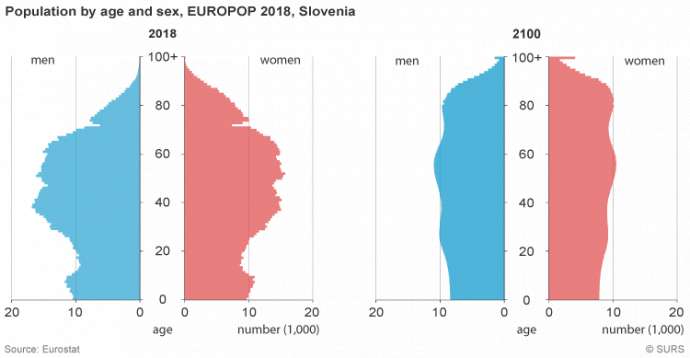STA, 19 December 2019 - There were 2,089,310 residents in Slovenia on 1 July 2019, of whom there were more men than women for the first time in 160 years, show the latest Statistics Office (SURS) data. There were 2,360 more men than women. This trend can only be seen in three other EU countries, Sweden, Malta and Luxembourg.
"This is mostly a result of immigration, since the majority of immigrants in Slovenia are men," Barica Razpotnik explained at Thursday's news conference in Ljubljana.
However, the immigrants excluded, the country's population increase was negative in the first six months, as the number of newborns was below the number of people who died.
Related: Survey - Young Slovenian Women Unhappy at Work, Would Move Abroad
Related: Where to Find the Most Women in Slovenia
Taking into account the immigrants, the increase in the country's population in January-June was positive.
As many as 28,455 moved to Slovenia last year and 13,527 moved out of it, so the difference of nearly 15,000 makes for the steepest rise in foreigners in 10 years.
As a result, the number of foreign citizens in Slovenia increased to 6.6% in 2018, Razpotnik said.
Half of the foreigners who immigrated here were from Bosnia and Herzegovina.
An average foreigner who moved to Slovenia last year was a 32-year old man with Bosnian citizenship who has completed vocational education and had a job in the construction industry.
The number of immigrants granted Slovenian citizenship in 2018 stood at 1,978, of whom two-thirds were from Bosnia. A third were children under 15.
SURS director general Bojan Nastov said that projections showed Slovenia's population would be rising until 2023 and then start to slowly drop to reach 1,796,000 in 2100.
Another major change in coming decades will a major increase in the number of older people.
Related: Slovenia’s Aging Population, in Graphic Form
At the moment 20% of Slovenia's residents are older than 65, but the share is projected to grow to almost 32% by 2055.
Interestingly, the number of centenaries, now at 200, is to grow to around 5,600 in 2100.
Around one million people in the third quarter of 2019 were persons in employment, who clocked in an average 34 hours of work a week.
Nastov said it was encouraging that unemployment rate in the first three quarters of the year was below 5%, as opposed to over 6% in the EU.
The average monthly net pay was EUR 1,114, up 3.7% in nominal and 2% in real terms.
Monthly pay has been rising in the private and public sectors, and could well result in the highest annual pay growth since 2008 by the end of the year.
Higher pay translated into more disposable household income; in the first half of the year it was by 7% higher than in the same period in 2017.
Retail prices rose by 2% from the start of the year until the end of November, with inflation mostly fuelled by higher prices of food and non-alcoholic beverages, but also services, with Nastov highlighting higher health insurance.
This year's inflation was somehow cushioned by lower prices of fuel and energy.
Housing prices in the second quarter of the year rose by nearly 6% and the value of all sold housing units in that period amounted to EUR 330 million.
Over the past year and a half, the number of used homes sold totalled a record 3,452, whereas only 42 new homes were sold in this period.
More on all this data can be found here






